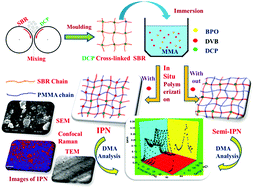Thermoplastic–elastomer composition based on an interpenetrating polymeric network of styrene butadiene rubber–poly(methyl methacrylate) as an efficient vibrational damper
Abstract
A new series of interpenetrating polymer networks (IPNs) and semi-IPNs based on styrene butadiene rubber (SBR) and poly[methyl methacrylate] (PMMA) have been synthesized by sequential polymerization. The synthesized IPNs show promise for application as vibrational dampers. Raman spectroscopy and imaging were successfully utilized to establish IPN formation for the first time. The different viscoelastic properties of the IPNs were investigated in detail. Rigidity, entanglement density and phase mixing at the interface were enhancing by increasing the PMMA loading. The significant inward shifts of the glass transition temperatures of the SBR and PMMA phases proved their mixing in the IPNs. The cross-linking of the SBR and PMMA phases contributed to the viscoelastic behavior of the IPNs. The semi-IPN with the same composition possessed a slightly higher storage modulus and damping property compared to the corresponding IPN. The experimental values of area under the linear loss modulus were larger than those obtained by group contribution analysis. Five different composite models were employed for theoretical predictions. Among them, the Davies model most accurately reproduced the experimental data. The homogeneity of the system was further studied with Cole–Cole analysis. Morphological analyses using SEM, AFM, and TEM provided clear insights into the component distributions in the IPNs. The co-continuous morphology of IPN predicted by DMA analysis, particularly at high PMMA concentration, is in good agreement with the morphological analyses and theoretical predictions. This protocol for IPN characterization can serve as a platform for designing new vibrational dampers and their chemistries.



 Please wait while we load your content...
Please wait while we load your content...